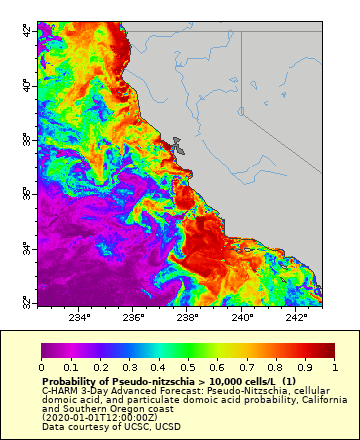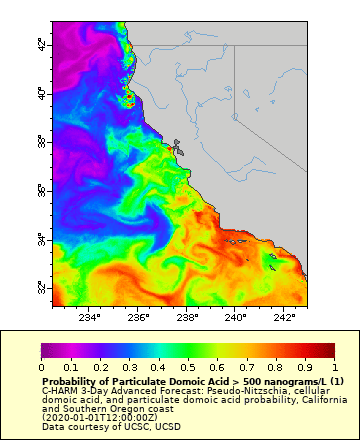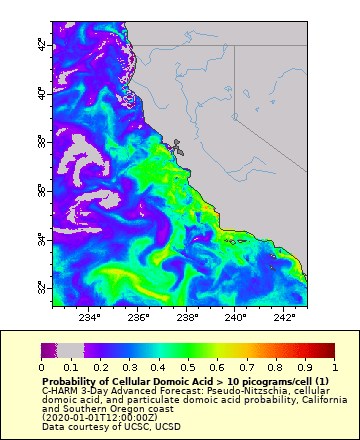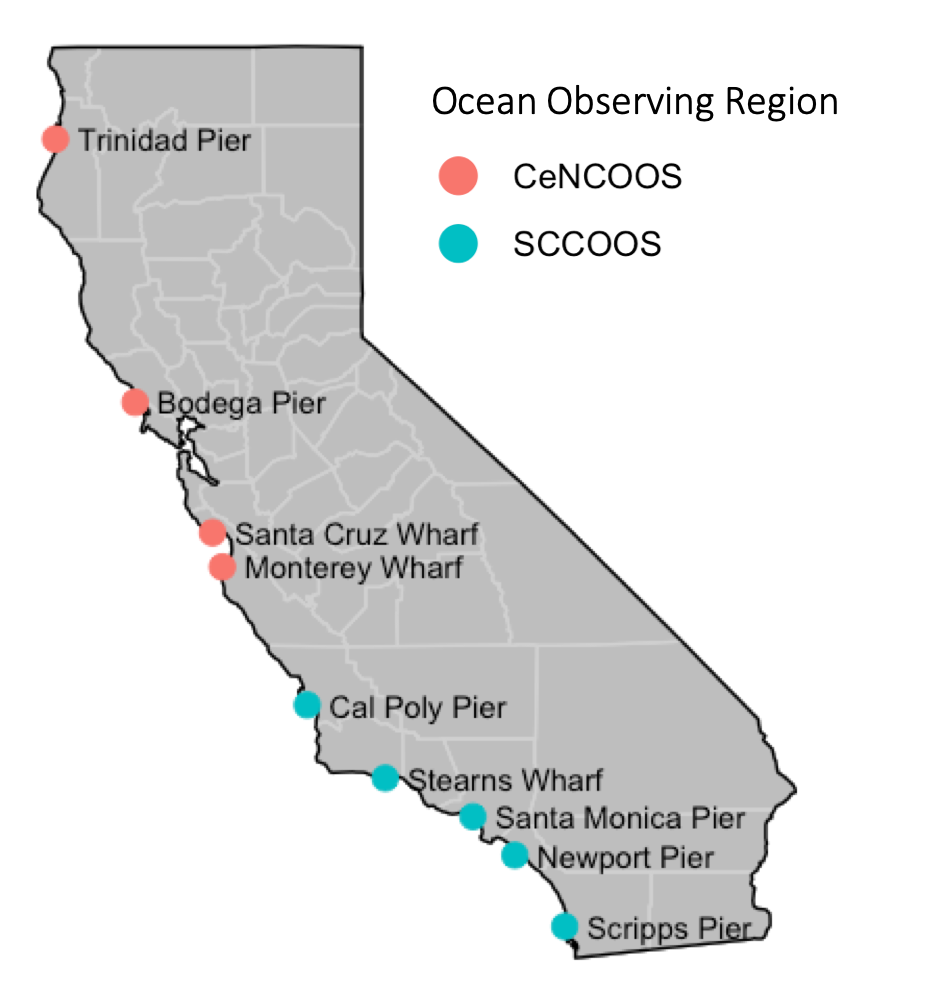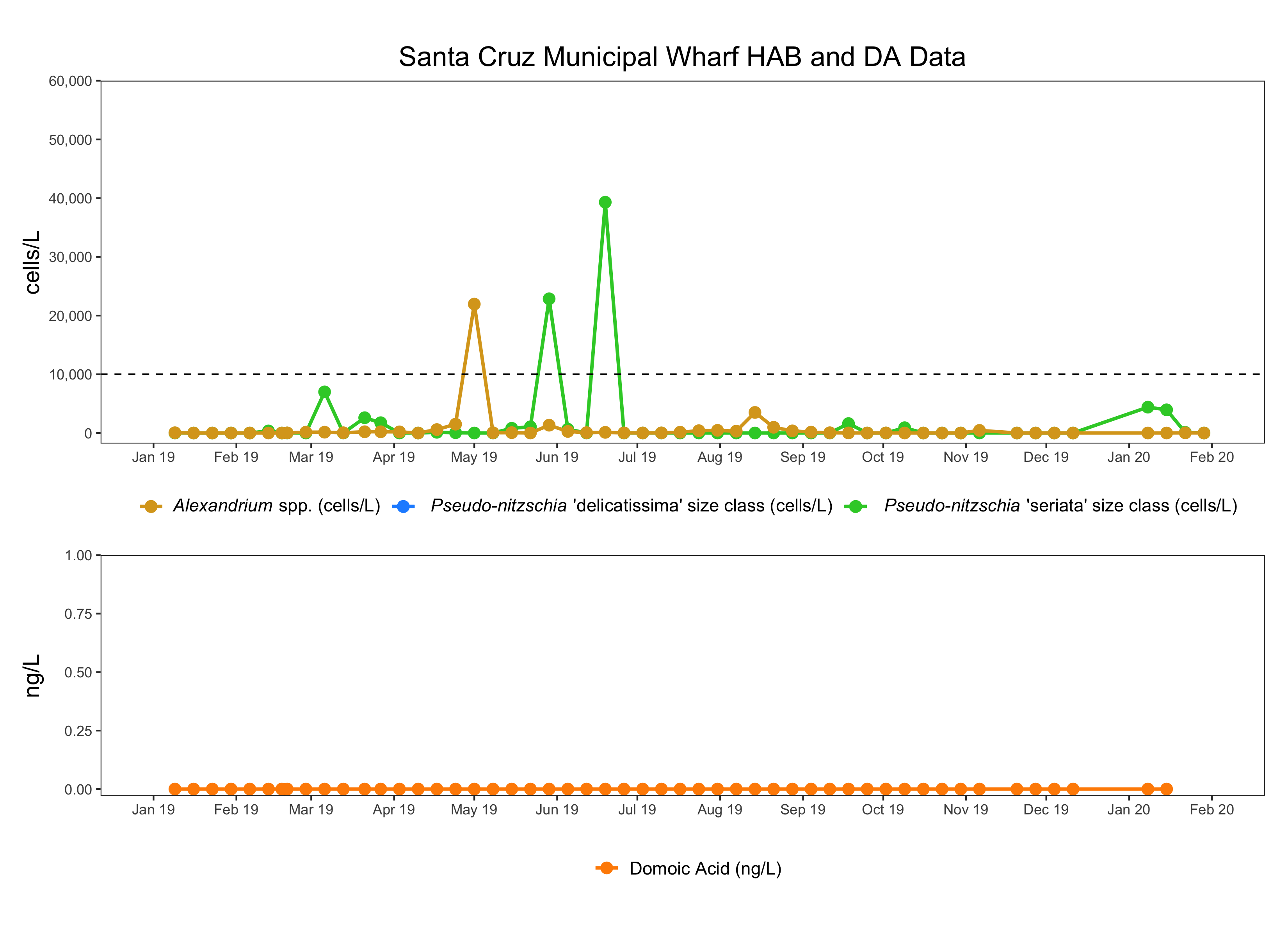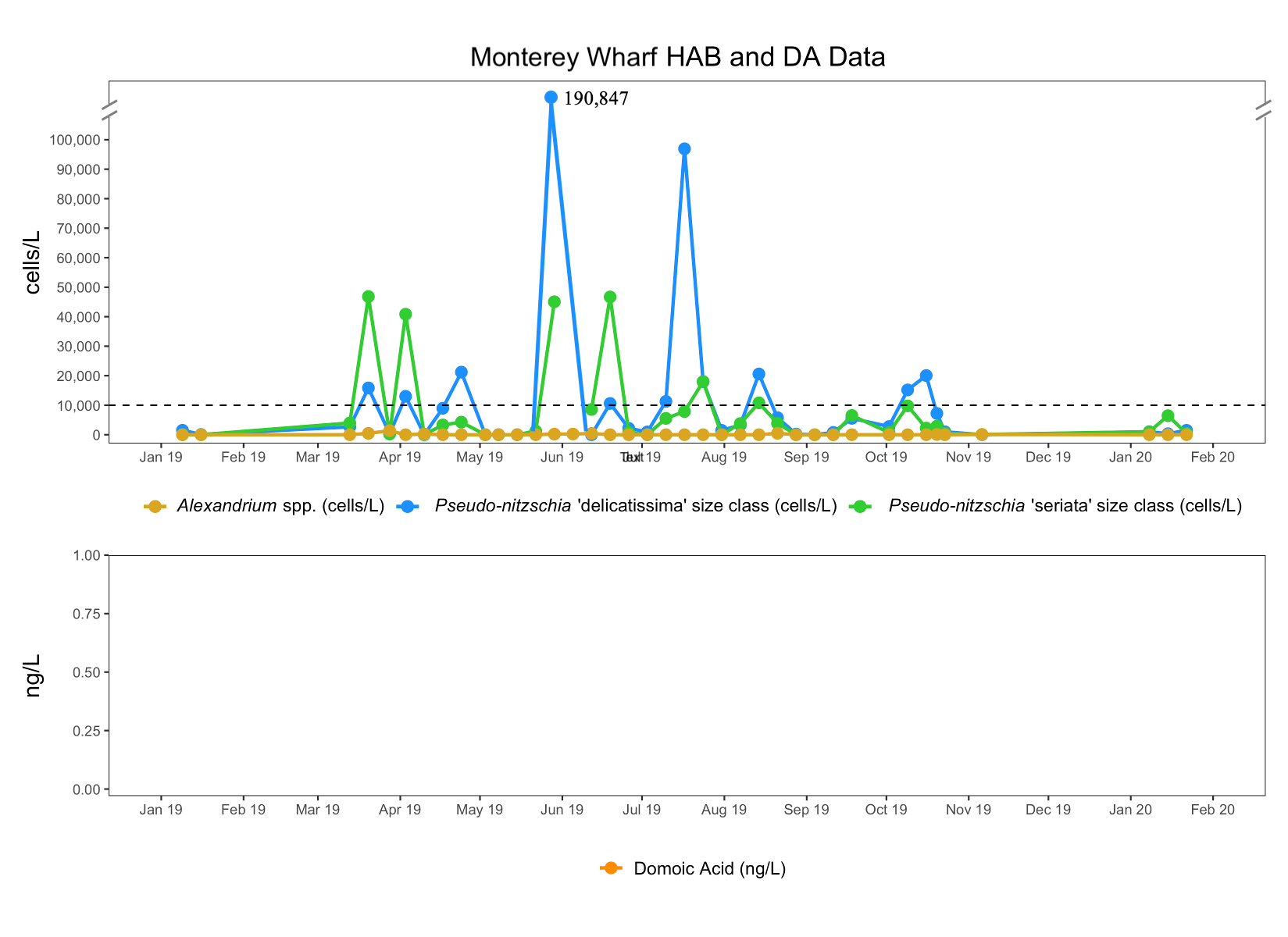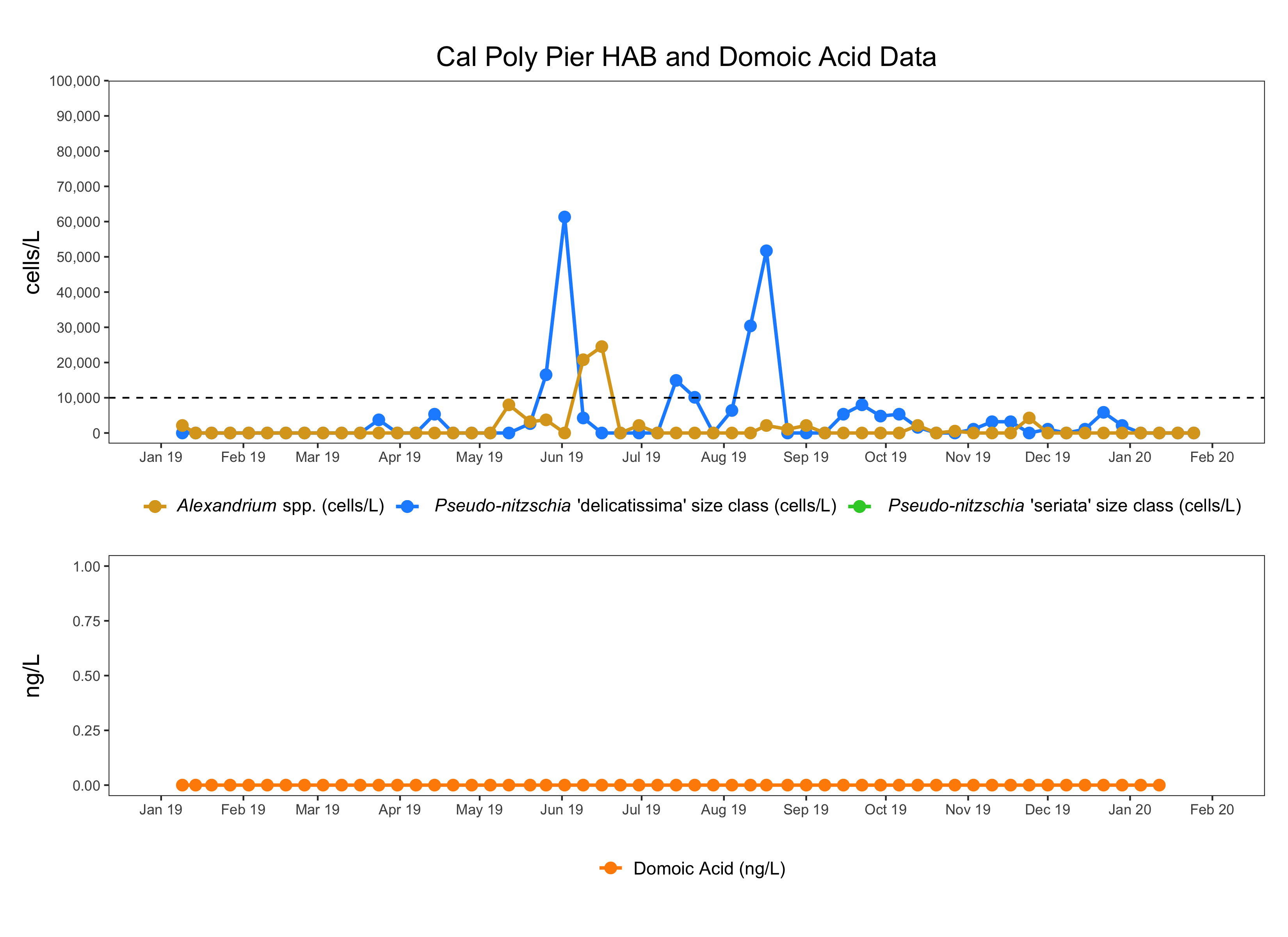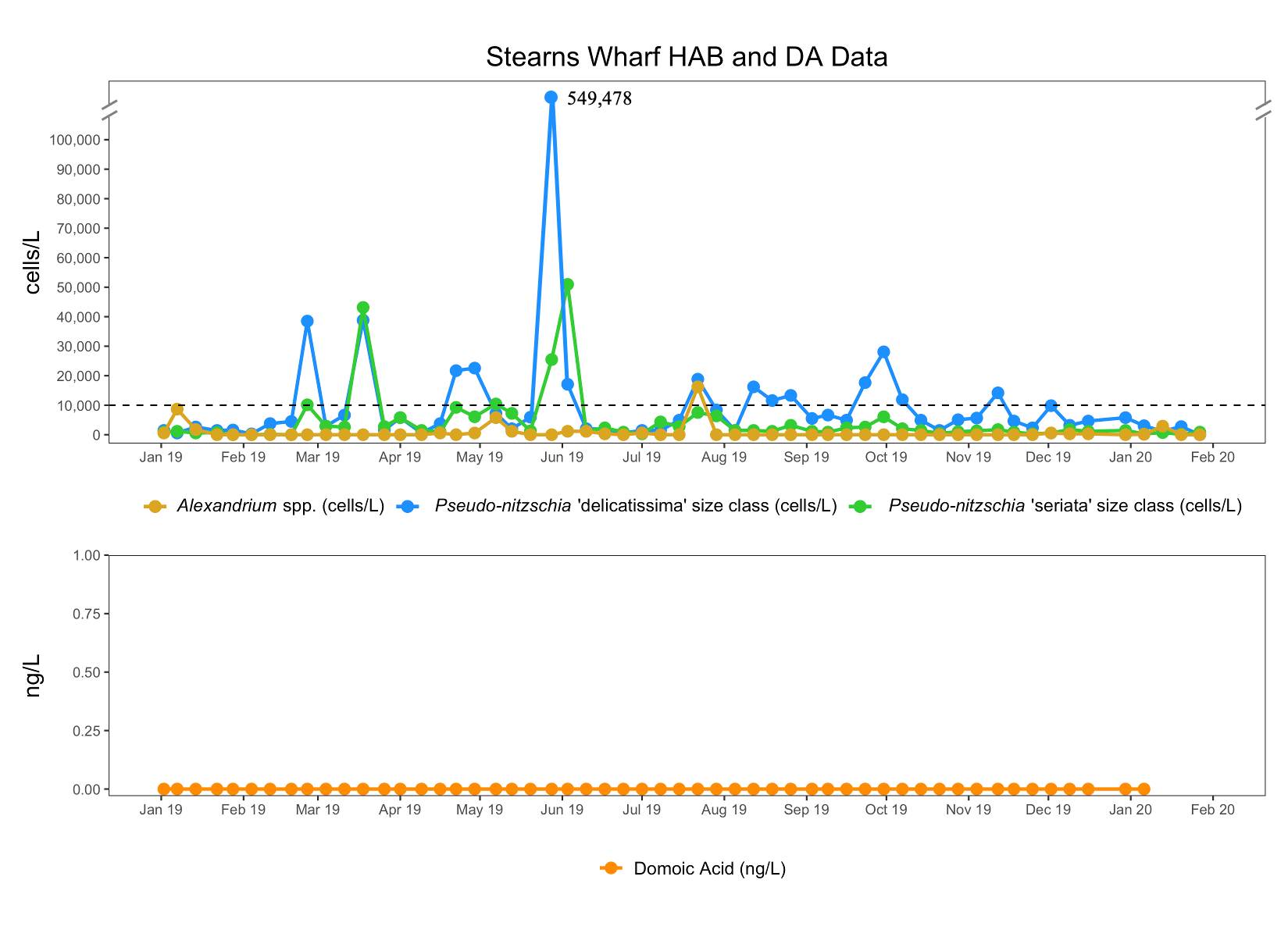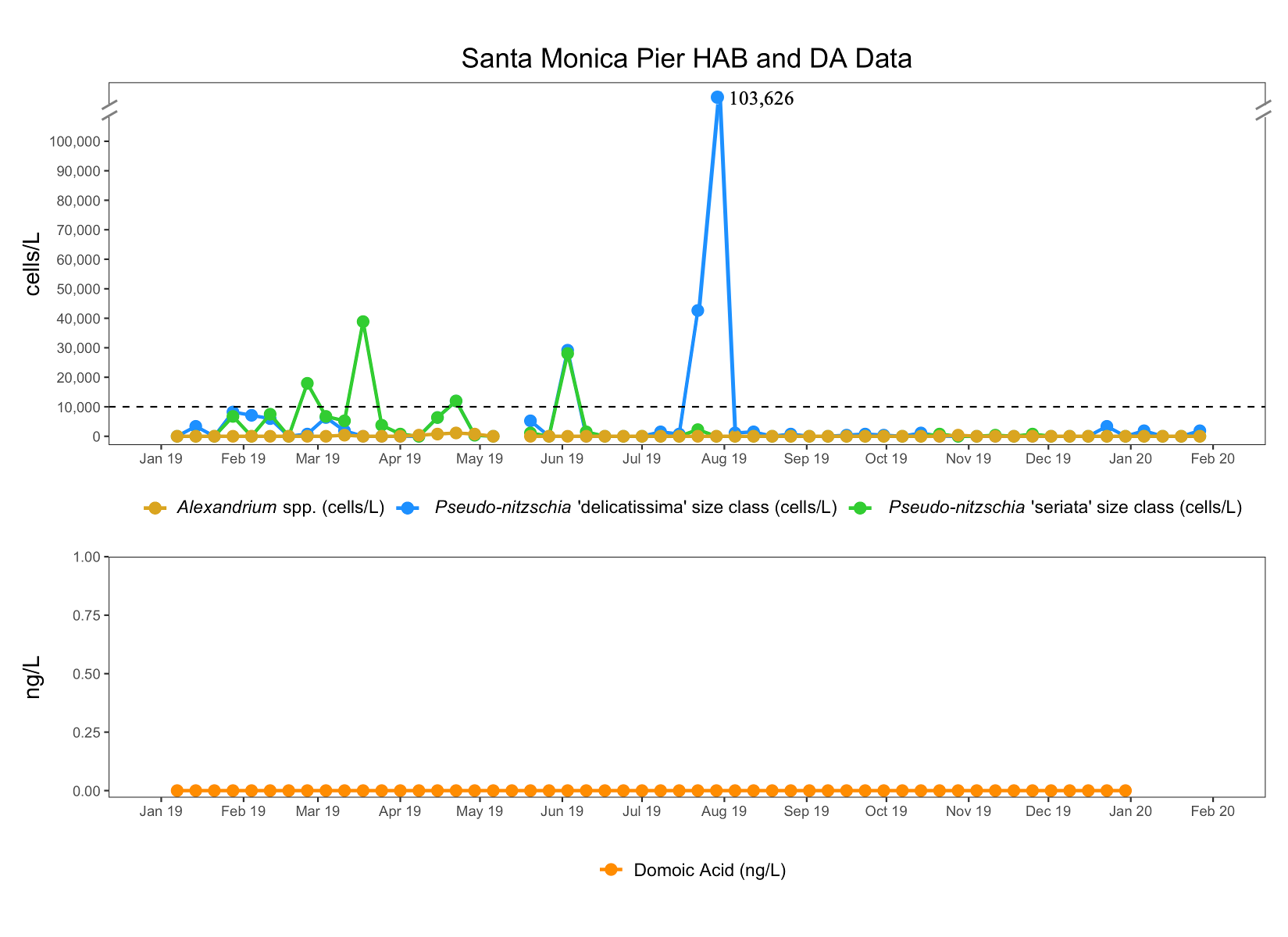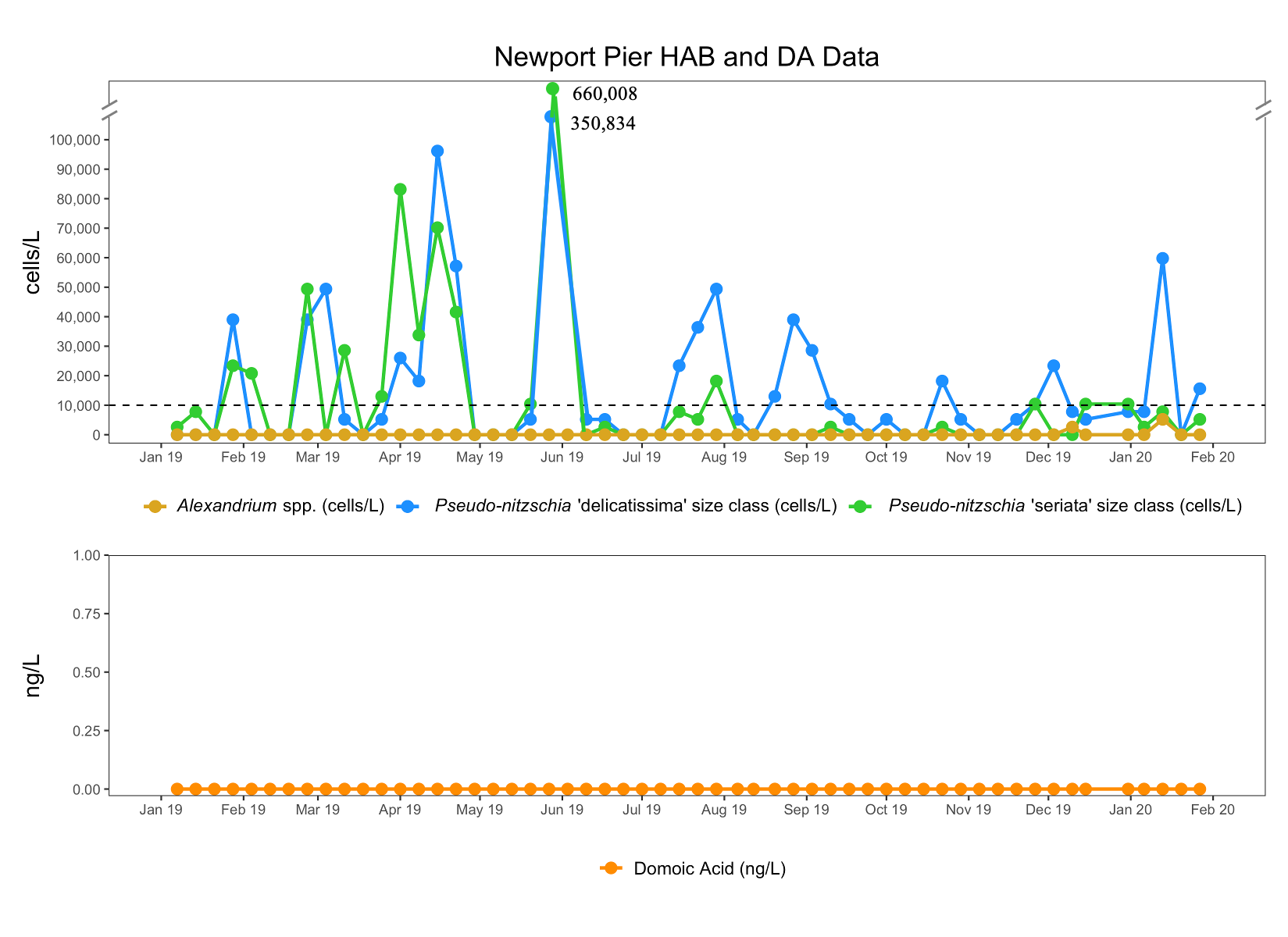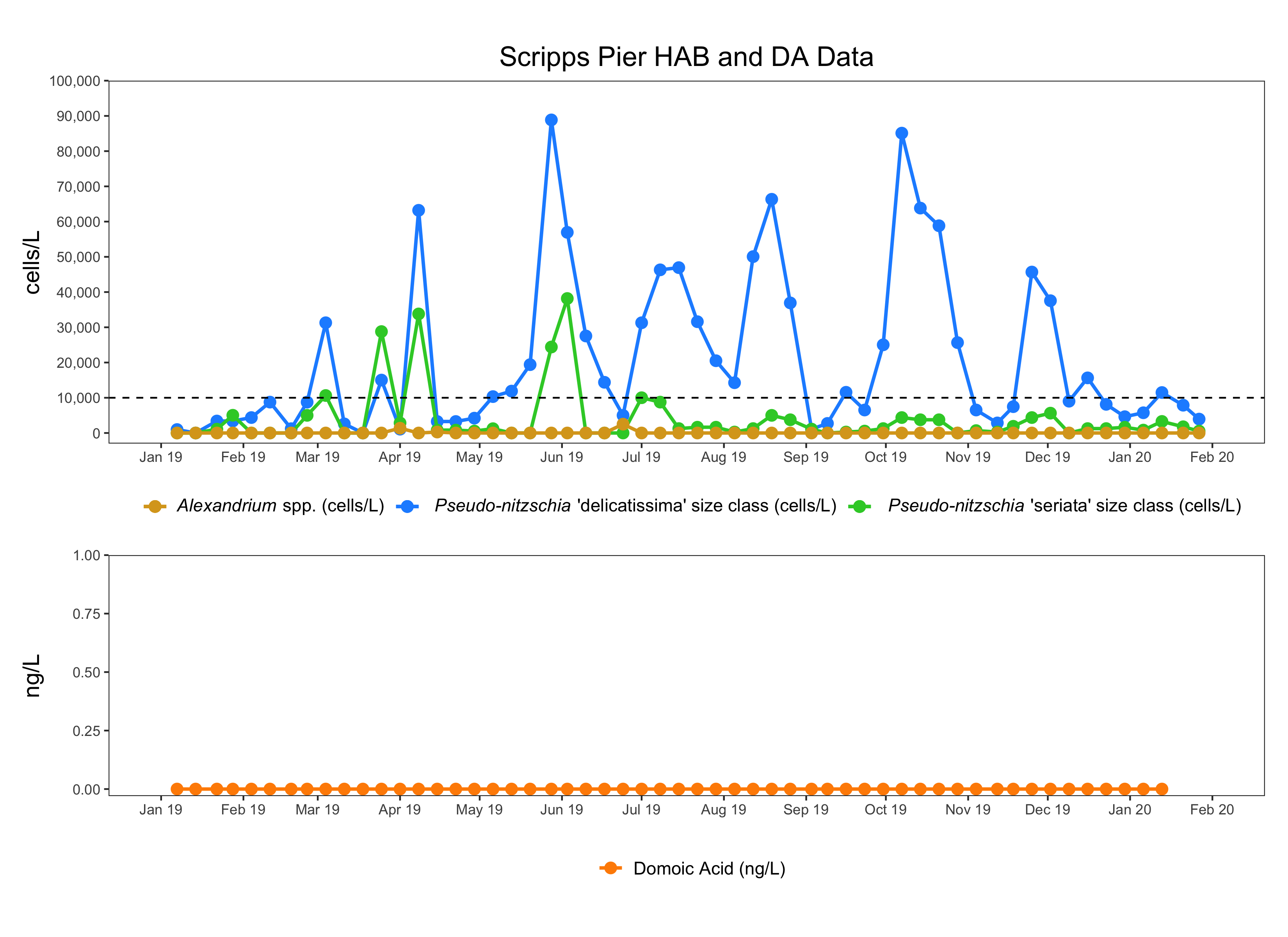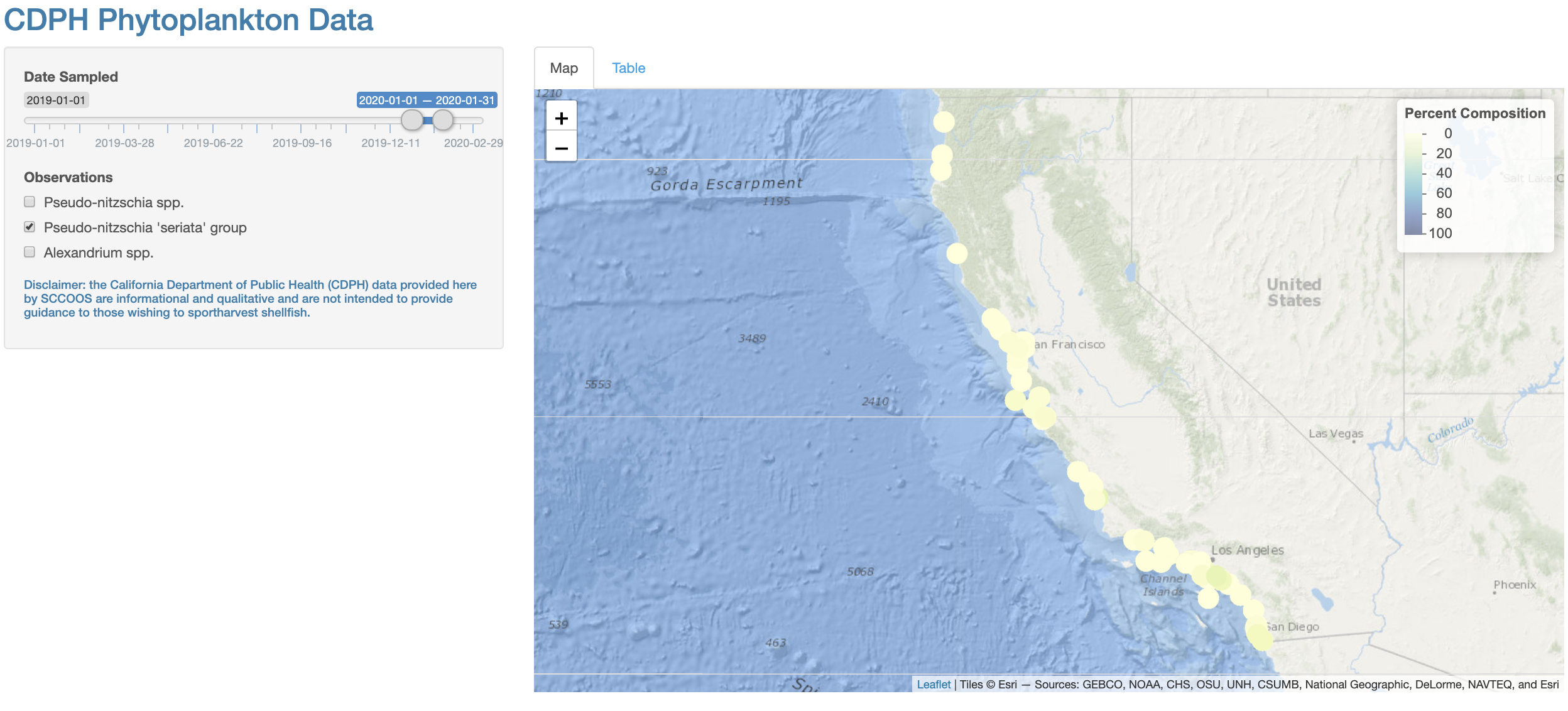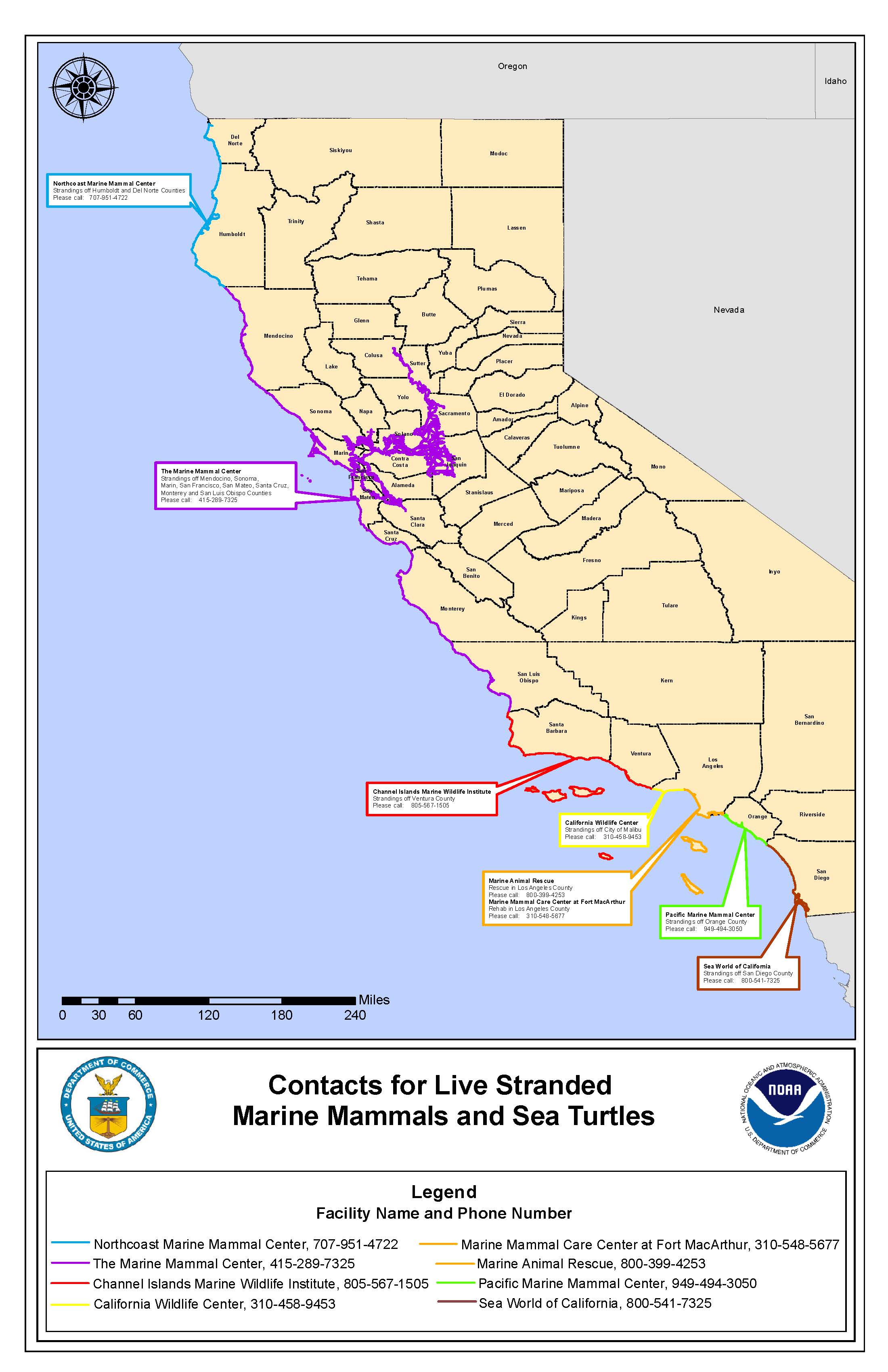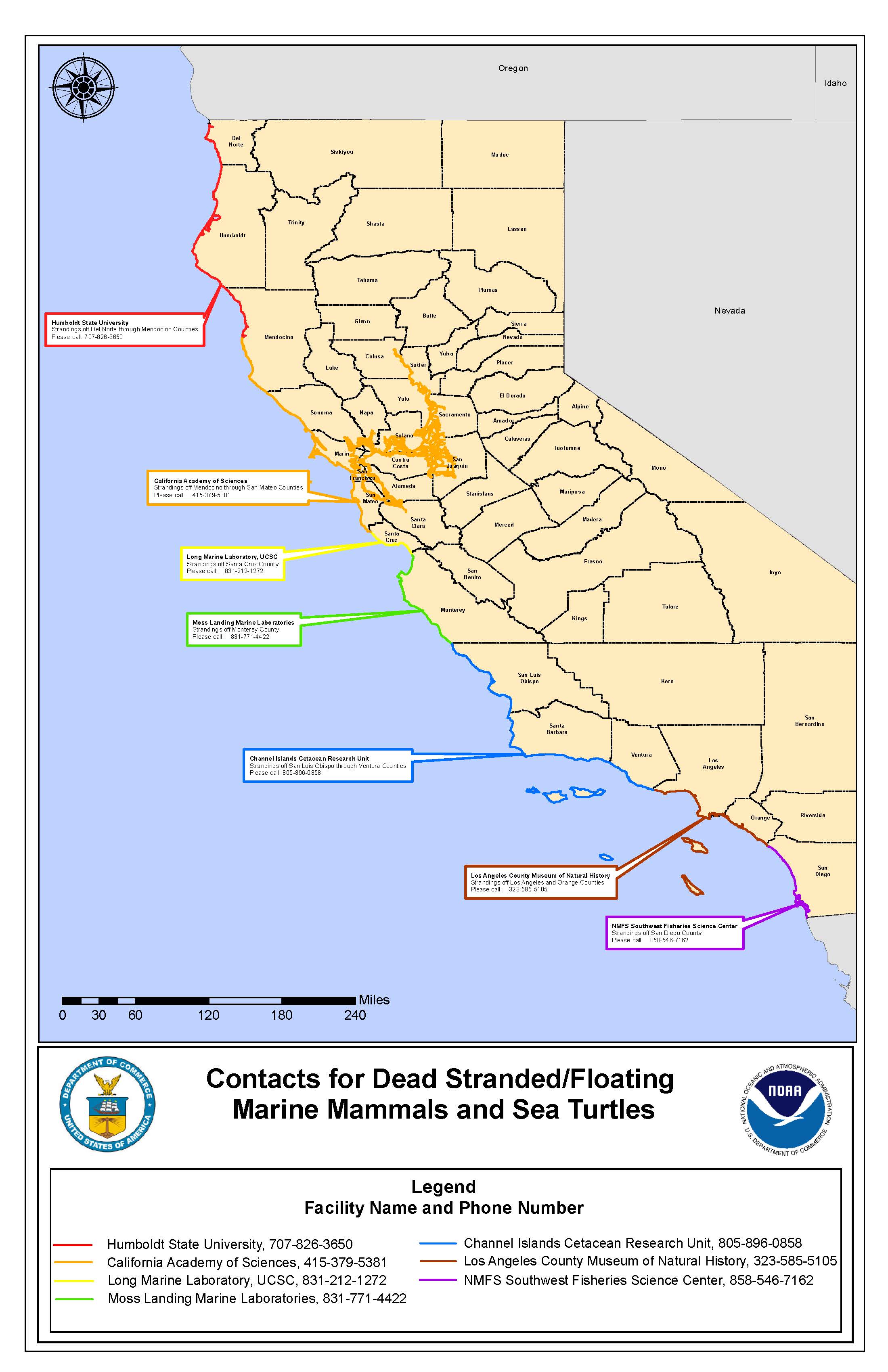Pseudo-nitzschia - C-HARM tells us where conditions are suitable for species of the diatom Pseudo-nitzschia spp. (all size classes) to grow well and where they might be more likely to produce domoic acid (DA). As in December, predicted suitable habitat for Pseudo-nitzschia spp. was fairly patchy throughout coastal California in January with a strong, persistent focus on central CA and the area around Pt. Conception as well as the area outside SF Bay, with more ephemeral periods of high bloom probability along the north coast. Patches of high Pseudo-nitzschia spp. bloom probability were predicted in a tight band along the coast in the Southern California Bight, notably in the San Pedro Bay area and near Orange and San Diego Counties. As in December, the Monterey Bay was mostly predicted to be a hot spot for Pseudo-nitzschia spp. in January. C-HARM predicted high but patchy probabilities of high particulate DA (pDA), with central CA again a focal point of activity, particularly for areas around the San Francisco Bay, Monterey Bay, and Pt Conception and the Santa Barbara Channel (SBC), as well as off the coast of San Luis Obispo (SLO) County. Northern California regions, such as Humboldt and Mendocino Counties, displayed generally low probabilities of pDA throughout January, in contrast to December when there were frequent episodes of high pDA probability in the northern counties. At the end of December, the high pDA probabilities in the Southern California Bight had become distinct maxima around San Diego and Orange Counties, and these persisted into January, consistent with Pseudo-nitzschia bloom predictions confined to a narrow band hugging the coastline. The patterns for cellular DA (cDA) probabilities were largely consistent with pDA, although enhanced and more restricted to central CA with foci in and around SF Bay, Monterey Bay, SLO county, Pt. Conception, the SBC, and southern counties, particularly Orange and San Diego Counties. Probabilities for cDA were notably low for those counties (and their offshore coastal regions) north of Sonoma, consistent with the lower pDA probabilities in those regions but inconsistent with episodes of high Pseudo-nitzschia blooms predicted for Humboldt and Del Norte Counties.
In comparison with the Harmful Algal Bloom Monitoring and Alert Program (HABMAP) measurements where we have January data currently available, Scripps Pier (San Diego County) and Newport Beach Pier (Orange County) both experienced blooms levels of Pseudo-nitzschia at the end of January, consistent with C-HARM predictions which showed potential for elevated abundances throughout the month but mostly towards the latter half of January. Just as was the case in December, the difference between the two sites was that P. "delicatissima" (the less toxigenic group) bloomed at Scripps Pier, with only slightly elevated abundances of P. "seriata" (the more toxigenic group), while in contrast, both bloomed at Newport Beach Pier at the end of January. Santa Monica Pier did not experience bloom levels of either size class of Pseudo-nitzschia spp., in contrast to the patchy C-HARM predictions of high bloom probabilities in San Pedro Bay and the LA area in the latter half of January. Pseudo-nitzschia spp. were detected below bloom levels at all other pier sites, although the larger and more toxigenic P. seriata size class almost reached 10,000 cells/L at Monterey Wharf and was elevated at Santa Cruz Wharf at the end of January, consistent with C-HARM predictions that Monterey Bay should experience blooms in January. Available domoic acid data for most piers has been zero (or below detection limits) since January 2019 despite a clear presence of DA in the environment as signaled by stranded animals from DA toxicosis throughout 2019 and in early 2020.
Notably, there were two sea lion strandings from suspected DA toxicosis in the LA and Monterey County areas in early January, consistent with C-HARM predictions for DA. San Luis Obispo, Monterey, and San Mateo Counties all saw 1-2 suspected DA toxicosis cases in December, consistent with C-HARM predictions of nearshore and offshore pDA and cDA at the end of December, likely the time when these animals would have been acquiring DA from their food source.
CDPH recorded their highest relative abundances of Pseudo-nitzschia "seriata" size class in the Orange County (Long Beach and Huntington Beach) area, consistent with HABMAP samples from Newport Beach Pier.
Alexandrium - There was an interesting, albeit slight, uptick in Alexandrium spp. activity, the causative organism of paralytic shellfish poisoning (PSP) in all samples collected by the CDPH near La Jolla (San Diego County). HABMAP sampling did not record any detectable Alexandrium cells in the month of January, even at Scripps Pier.
C-HARM Model
HABMAP Observations
Note that data for some stations are not shown because they are not yet recorded in the public HABMAP archive.
Differentiating Pseudo-nitzschia species by light microscopy is difficult. For this reason, Pseudo-nitzschia "seriata" does not refer to an actual species but rather the larger size class of Pseudo-nitzschia, which is generally a more toxigenic group of species. Alternatively, Pseudo-nitzschia "delicatissima" refers to the smaller size class that is generally non-toxigenic. The dashed line on the plots demarcates the 10,000 cells/L "bloom" threshold designated here for Pseudo-nitzschia populations only.
More information and data visualizations on the statewide HAB network and forecasting system can be found here and on the SCCOOS HABMAP page.
Santa Cruz Wharf
Water samples were collected at Santa Cruz Wharf four times in the month of January. Molecular probes for toxigenic Pseudo-nitzschia in the "seriata" class are conducted for this site, and was detected below bloom levels on January 8th, 15th and 22nd. Domoic acid was not detected in the month of January. Santa Cruz Wharf does not count for Pseudo-nitzschia delicatissima group.
The Santa Cruz Wharf shore station is supported by CeNCOOS PI Raphael Kudela at UCSC.
Monterey Wharf
Water samples were collected at Monterey Wharf three times in the month of January. Pseudo-nitzschia seriata and delicatissima group were detected below bloom levels on January 8th, 15th and 22nd and Alexandrium spp. were not detected in any of the water samples. Domoic acid results are not yet available for the month of January.
Monterey Wharf shore station is supported by CeNCOOS PI Jason Smith and Moss Landing Marine Labs and Raphael Kudela at UCSC.
Cal Poly Pier
Water samples at Cal Poly Pier were collected four times in the month of January. Pseudo-nitzschia delicatissima group and Alexandrium spp. were not detected in any of the samples. Domoic Acid was not detected on January 5th or 12th and results are not yet available for end of January samples.
Cal Poly Pier shore station is supported by SCCOOS PI Ryan Walter and Ally Pasulka at Cal Poly.
Stearns Wharf
Water samples were collected at Stearns Wharf four times in the month of January. Pseudo-nitzschia delicatissima group was detected below bloom levels on January 6th, 13th and 20th and Pseudo-nitzschia seriata group was detected below bloom levels in all four samples. Alexandrium spp. were detected on January 6th and 13th. Domoic acid results are not yet available for the month of Janaury.
Stearns Wharf is supported by SCCOOS PI Mark Brzezinski and Libe Washburn at UCSB.
Santa Monica Pier
Water samples were collected at Santa Monica Pier four times in the month of January. Pseudo-nitzschia delicatissima group was detected below bloom levels on January 6th and 27th. Pseudo-nitzschia seriata and Alexandrium spp. were not detected in any of the samples. Domoic acid results are not yet available for the month of January.
Santa Monica Pier shore station is supported by SCCOOS PI Rebecca Shipe at UCLA.
Newport Beach Pier
Water samples were collected at Newport Beach Pier four times in the month of January. Pseudo-nitzschia delicatissima group was detected above bloom levels on January 13th and 27th. Pseudo-nitzschia seriata group was detected below bloom levels on January 6th, 13th and 27th and Alexandrium spp. were detected on January 13th. Domoic acid was not detected in any of the four water samples in the month of January.
New Port Pier is supported by SCCOOS PI David Caron at USC.Scripps Pier
Water samples were collected four times at Scripps Pier in the month of January. Pseudo-nitzschia delicatissima group was detected above bloom levels on January 13th and below bloom levels on January 6th, 21st and 27th. Pseudo-nitzschia seriata group was detected below bloom levels in all four water samples and Alexandrium spp. were not detected in any of the water samples. Domoic acid was not detected on January 6th or 13th and results are not yet available for January 21st and 27th.
Scripps Pier is supported by SCCOOS and PIs Melissa Carter and Clarissa Anderson at UCSD.
CDPH observations for Pseudo-nitzschia spp. and Alexandrium spp.
Please note CDPH recently moved to only reporting Pseudo-nitzschia of the seriata complex and not all Pseudo-nitzschia spp. as previously provided.
From 1-31 January 2020, water samples were collected by volunteers and sent to the California Department of Public Health (CDPH) for analysis. Pseudo-nitzschia seriata group were detected in 48 of the 102 samples. Pseudo-notzschia seriata was detected at common density level on January 31st at Belmont Pier (15% composition) and Bolsa Chica (11% composition). Alexandrium spp. were detected in 7 of 7 samples in the month of January at very low density levels (<1% composition) except on January 15th at the South La Jolla Marine Reserve (8% composition).
You can also view CDPH weekly map layers of Pseudo-nitzschia and Alexandrium spp. here or you can view an interactive map and data table of CDPH data from January 2019 to present developed by SCCOOS here.
Data are provided by the California Department of Public Health, Environmental Management Branch.
CDPH and OEHHA Health Advisories
California Department of Public Health (CDPH) released no health advisories for fisheries and aquaculture in January 2020. For the latest closures and updates, please visit the CDFW Health Advisories page as a central location of information related to CDPH and/or OEHHA health advisories.
On July 30, 2019 the Office of Environmental Health Hazard Assessment (OEHHA) hosted the Domoic Acid Webinar: Research on Effects of Repeat Low-Level Exposures and Its Implications for Human Toxicity. The recorded webinar can be found here.
California Marine Mammal and Seabird Strandings from Suspected DA Toxicosis
Domoic acid (DA) is a potent neurotoxin produced by some diatom species of the genus Pseudo-nitzschia. Species exposed to DA can result in seizures, epilepsy, cardiomyopathy, and death depending upon the ingested dose. DA toxicosis commonly occurs in California Sea Lions (Zalophus californianus), presumably due to a combination of foraging behavior and seasonal movements. The Marine Mammal Center (TMMC), the California Wildlife Center (CWC), the Marine Mammal Care Center Los Angeles (MMCC-LA), Marine Animal Rescue (MAR), the Pacific Marine Mammal Center (PMMC), and SeaWorld act like an emergency room by working to rescue and rehabilitate sick and injured marine mammals, seabirds, and sea turtles.
Among the six rehabilitation centers we have data for a total of two marine mammal strandings that presented with symptoms of domoic acid toxicosis in the month of January.
California Wildlife Center, Marine Animal Rescue, Pacific Marine Mammal Center and SeaWorld did not record any strandings due to suspected domoic acid in January 2020.
January strandings due to suspected DA toxicosis occurred in the following counties:
- Monterey (TMMC)
- January 6th, juvenile, male, California Sea Lion
- Los Angeles (MMCC-LA)
- January 7th, adult, female, California Sea Lion
At this time we do not have data from the North Coast Marine Mammal Center or the Channel Islands Marine Wildlife Institute.
Please subscribe to CA HAB Bulletin listserv to receive the monthly CA HAB Bulletin.

